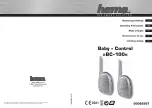
23
3.
If there is an error in obtaining a measurement, indicated by three beeps, please refer
to the troubleshooting tips on page 40 and take the appropriate remedial measure.
Taking a measurement on each arm helps rule out dissecting aneurysms,
coarctation of the aorta, vascular obstruction and possible errors in
measurement.
1
You can find more tips like this in the American Heart Association‘s
current scientific statement on recommendations for blood pressure
measurement.
Taking a Manual
SphygMode Measurement
1.
With the patient prepped as described earlier (page 20), and the device powered on,
palpate the brachial artery at the antecubital fossa. Place your stethoscope over this
space.
2.
Press and hold the
SphygMode
manual button
until you inflate the cuff to a
level at least 30 mmHg higher than the patient‘s systolic pressure.
3.
Once the cuff has been inflated to the desired level, release the
SphygMode
manual
button. The cuff begins to deflate at approximately 3mmHg/sec and the device
displays the cuff pressure.
4.
While listening to your stethoscope, note the systolic and diastolic pressures
corresponding to the first and last Korotkoff sounds (K-sounds) heard.
Press the
SphygMode
manual button
to re-inflate the cuff.
Press the automatic button
if you need to rapidly release all the air
from the cuff.
1
Circulation. AHA Scientific Statement: Recommendations for Blood Pressure Measurement in
Humans and Experimental Animals, Part 1: Blood Pressure Measurement in Humans: A Statement for
Professionals From the Subcommittee of Professional and Public Education of the American Heart
Associations Council on High Blood Pressure Research. Thomas G. Pickering, MD, DPhil; John E. Hall,
PhD; Lawrence J. Appel, MD; Bonita E. Falkner, MD; John Graves, MD; Martha N. Hill, RN, PhD;
Daniel W. Jones, MD; Theodore Kurtz, MD; Sheldon G. Sheps, MD; Edward J. Roccella, PhD, MPH,
2005;111:697-716.
















































